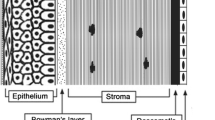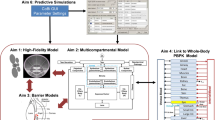Abstract
Purpose. To determine corneal absorption and desorption rate constants in a corneal epithelial cell culture model and to apply them to predict ocular pharmacokinetics after topical ocular drug application.
Method. In vitro permeation experiments were performed with a mixture of six β-blockers using an immortalized human corneal epithelial cell culture model. Disappearance of the compounds from the apical donor solution and their appearance in the basolateral receiver solution were determined and used to calculate the corneal absorption and desorption rate constants. An ocular pharmacokinetic simulation model was constructed for timolol with the Stella® program using the absorption and desorption rate constants and previously published in vivo pharmacokinetic parameters.
Results. The corneal absorption rates of β-blockers increased significantly with the lipophilicity of the compounds. The pharmacokinetic simulation model gave a realistic mean residence time for timolol in the cornea (57 min) and the aqueous humor (90 min). The simulated timolol concentration in the aqueous humor was about 1.8 times higher than the previously published experimental values.
Conclusions. The simulation model gave a reasonable estimate of the aqueous humor concentration profile of timolol. This was the first attempt to combine cell culture methods and pharmacokinetic modeling for prediction of ocular pharmacokinetics. The wider applicability of this approach remains to be seen.
Similar content being viewed by others
References
I. Ahmed and T. F. Patton. Disposition of timolol and inulin in the rabbit eye following corneal versus non–corneal absorption. Int. J. Pharm. 38:9–21 (1987).
D. S. Chien, J. J. Homsy, C. Gluchowski, and D. D. Tang–Liu. Corneal and conjunctival/scleral penetration of p–aminoclonidine, AGN 190342, and clonidine in rabbit eyes. Curr. Eye Res. 9:1051–1059 (1990).
H.–S. Huang, R. D. Schoenwald, and J. L. Lach. Corneal penetration behavior of β–blocking agents II: Assessment of barrier contributions. J. Pharm. Sci. 72:1272–1279 (1983).
M. R. Prausnitz and J. S. Noonan. Permeability of cornea, sclera, and conjunctiva: A literature analysis for drug delivery to the eye. J. Pharm. Sci. 87:1479–1488 (1998).
R. D. Schoenwald. Ocular drug delivery. Pharmacokinetic considerations. Clin. Pharmacokinet. 18:255–269 (1990).
D. S. Chien, H. Sasaki, H. Bundgaard, A. Buur, and V. H. L. Lee. Role of enzymatic lability in the corneal and conjunctival penetration of timolol ester prodrugs in the pigmented rabbit. Pharm. Res. 8:728–733 (1991).
P. Suhonen, T. Järvinen, P. Rytkönen, P. Peura, and A. Urtti. Improved corneal pilocarpine permeability with O,O′–(1,4–xylylene) bispilocarpic acid ester double prodrugs. Pharm. Res. 8:1539–1542 (1991).
J. W. Sieg and J. R. Robinson. Mechanistic studies on transcorneal permeation of pilocarpine. J. Pharm. Sci. 65:1816–1822 (1976).
V. H. L. Lee, A. M. Luo, S. Li, S. K. Podder, J. S.–C. Chang, S. Ohdo, and G. M. Grass. Pharmacokinetic basis for nonadditivity of intraocular pressure lowering in timolol combinations. Invest. Ophthalmol. Vis. Sci. 32:2948–2957 (1991).
S. C. Miller, K. J. Himmelstein, and T. F. Patton. A physiologically based pharmacokinetic model for the intraocular distribution of pilocarpine in rabbits. J. Pharmacokinet. Biopharm. 9:653–677 (1981).
K. Yamamura, H. Sasaki, M. Nakashima, M. Ichikawa, T. Mukai, K. Nishida, and J. Nakamura. Characterization of ocular pharmacokinetics of beta–blockers using a diffusion model after instillation. Pharm. Res. 16:1596–1601 (1999).
K. L. Audus, R. L. Bartel, I. J. Hidalgo, and R. T. Borchardt. The use of cultured epithelial and endothelial cells for drug transport and metabolism studies. Pharm. Res. 7:435–451 (1990).
J.–E. Chang, S. K. Basu, and V. H. L. Lee. Air–interface condition promotes the formation of tight corneal epithelial cell layers for drug transport studies. Pharm. Res. 17:670–676 (2000).
C. R. Kahn, E. Young, I. H. Lee, and J. S. Rhim. Human corneal epithelial primary cultures and cell lines with extended life span: in vitro model for ocular studies. Invest. Ophthalmol. Vis. Sci. 34:3429–3441 (1993).
E. Toropainen, V.–P. Ranta, A. Talvitie, P. Suhonen, and A. Urtti. Culture model of human corneal epithelium for prediction of ocular drug absorption. Invest. Ophthalmol. Vis. Sci. 42:2942–2948 (2001).
K. Araki–Sasaki, Y. Ohashi, T. Sasabe, K. Hayashi, H. Watanabe, Y. Tano, and H. Handa. An SV40–immortalized human corneal epithelial cell line and its characterization. Invest. Ophthalmol. Vis. Sci. 36:614–621 (1995).
V.–P. Ranta, E. Toropainen, A. Talvitie, S. Auriola, and A. Urtti. Simultaneous determination of eight β–blockers by gradient high–performance liquid chromatography with combined ultraviolet and fluorescence detection in corneal permeability studies in vitro. J. Chromatogr. B 77:81–87 (2002).
M. A. Watsky, M. M. Jablonski, and H. F. Edelhauser. Comparison of conjunctival and corneal surface areas in rabbit and human. Curr. Eye Res. 7:483–486 (1988).
S. S. Chrai, T. F. Patton, A. Mehta, and J. R. Robinson. Lacrimal and instilled fluid dynamics in rabbit eyes. J. Pharm. Sci. 62:1112–1121 (1973).
R. D. Schoenwald and H.–S. Huang. Corneal penetration behavior of β–blocking agents I: Physicochemical factors. J. Pharm. Sci. 72:1266–1272 (1983).
W. Wang, H. Sasaki, D.–S. Chien, and V. H. L. Lee. Lipophilicity influence on conjunctival drug penetration in the pigmented rabbit: a comparison with corneal penetration. Curr. Eye Res. 6:571–579 (1991).
I. Ahmed, R. D. Gokhale, M. V. Shah, and T. F. Patton. Physicochemical determinants of drug diffusion across the conjunctiva, sclera, and cornea. J. Pharm. Sci. 76:583–586 (1987).
K. Järvinen, E. Vartiainen, and A. Urtti. Optimizing the systemic and ocular absorption of timolol from eye–drops. STP Pharm. Sci. 2:105–110 (1992).
M. L. Francoeur, S. J. Sitek, B. Costello, and T. F. Patton. Kinetic disposition and distribution of timolol in the rabbit eye. A physiologically based ocular model. Int. J. Pharm. 25:275–292 (1985).
S. Burgalassi, P. Chetoni, L. Panichi, E. Boldrini, and M. F. Saettone. Xyloglucan as a novel vehicle for timolol: Pharmacokinetics and pressure lowering activity in rabbits. J. Ocul. Pharmacol. Ther. 16:497–509 (2000).
T. F. Patton and J. R. Robinson. Ocular evaluation of polyvinyl alcohol vehicle in rabbits. J. Pharm. Sci. 64:1312–1316 (1975).
S.–C. Chang, D.–S. Chien, H. Bundgaard, and V. H. L. Lee. Relative effectiveness of prodrug and viscous solution approaches in maximizing the ratio of ocular to systemic absorption of topically applied timolol. Exp. Eye Res. 46:59–69 (1988).
S.–C. Chang and V. H. L. Lee. Nasal and conjunctival contributions to the systemic absorption of topical timolol in the pigmented rabbit: Implications in the design of strategies to maximize the ratio of ocular to systemic absorption. J. Ocul. Pharmacol. 3:159–169 (1987).
A. Urtti, J. D. Pipkin, G. Rork, T. Sendo, U. Finne, and A. J. Repta. Controlled drug delivery devices for experimental ocular studies with timolol 2. Ocular and systemic absorption in rabbits. Int. J. Pharm. 61:241–249 (1990).
R. Jani, O. Gan, Y. Ali, R. Rodstrom, and S. Hancock. Ion exchange resins for ophthalmic delivery. J. Ocul. Pharmacol. 10:57–67 (1994).
G. M. Grass and V. H. L. Lee. A model to predict aqueous humor and plasma pharmacokinetics of ocularly applied drugs. Invest. Ophthalmol. Vis. Sci. 34:2251–2259 (1993).
R. D. Schoenwald. Ocular pharmacokinetics/pharmacodynamics. In A. K. Mitra (ed.) Ophthalmic Drug Delivery Systems, Marcel Dekker, New York, 1993, pp. 83–110.
Author information
Authors and Affiliations
Corresponding author
Rights and permissions
About this article
Cite this article
Ranta, VP., Laavola, M., Toropainen, E. et al. Ocular Pharmacokinetic Modeling Using Corneal Absorption and Desorption Rates from in Vitro Permeation Experiments with Cultured Corneal Epithelial Cells. Pharm Res 20, 1409–1416 (2003). https://doi.org/10.1023/A:1025754026449
Issue Date:
DOI: https://doi.org/10.1023/A:1025754026449




